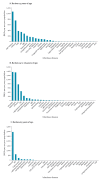Impact of infectious diseases on population health using incidence-based disability-adjusted life years (DALYs): results from the Burden of Communicable Diseases in Europe study, European Union and European Economic Area countries, 2009 to 2013
- PMID: 29692315
- PMCID: PMC5915974
- DOI: 10.2807/1560-7917.ES.2018.23.16.17-00454
Impact of infectious diseases on population health using incidence-based disability-adjusted life years (DALYs): results from the Burden of Communicable Diseases in Europe study, European Union and European Economic Area countries, 2009 to 2013
Abstract
Background and aimsThe Burden of Communicable Diseases in Europe (BCoDE) study aimed to calculate disability-adjusted life years (DALYs) for 31 selected diseases in the European Union (EU) and European Economic Area (EEA). Methods: DALYs were estimated using an incidence-based and pathogen-based approach. Incidence was estimated through assessment of data availability and quality, and a correction was applied for under-estimation. Calculation of DALYs was performed with the BCoDE software toolkit without applying time discounting and age-weighting. Results: We estimated that one in 14 inhabitants experienced an infectious disease episode for a total burden of 1.38 million DALYs (95% uncertainty interval (UI): 1.25-1.5) between 2009 and 2013; 76% of which was related to the acute phase of the infection and its short-term complications. Influenza had the highest burden (30% of the total burden), followed by tuberculosis, human immunodeficiency virus (HIV) infection/AIDS and invasive pneumococcal disease (IPD). Men had the highest burden measured in DALYs (60% of the total), adults 65 years of age and over had 24% and children less than 5 years of age had 11%. Age group-specific burden showed that infants (less than 1 year of age) and elderly people (80 years of age and over) experienced the highest burden. Conclusions: These results provide baseline estimates for evaluating infectious disease prevention and control strategies. The study promotes an evidence-based approach to describing population health and assessing surveillance data availability and quality, and provides information for the planning and prioritisation of limited resources in infectious disease prevention and control.
Keywords: HIV/AIDS, tuberculosis; burden of communicable diseases in Europe; disability-adjusted life years; infectious disease surveillance; influenza; prioritisation in public health; public health policy.
Conflict of interest statement
Figures








References
-
- Lopez AD, Mathers CD, Ezzati M, Jamison DT, Murray CJL, editors. Global Burden of Disease and Risk Factors. New York: Oxford University Press; 2006.
-
- Public Health Group of the Department of Human Services. Victorian Burden of Disease Study: Mortality and morbidity in 2001. Melbourne: Victoria Government Department of Human Services; 2005. Available from: https://www2.health.vic.gov.au/public-health/population-health-systems/h...
Publication types
MeSH terms
LinkOut - more resources
Full Text Sources
Other Literature Sources
Medical
Molecular Biology Databases
